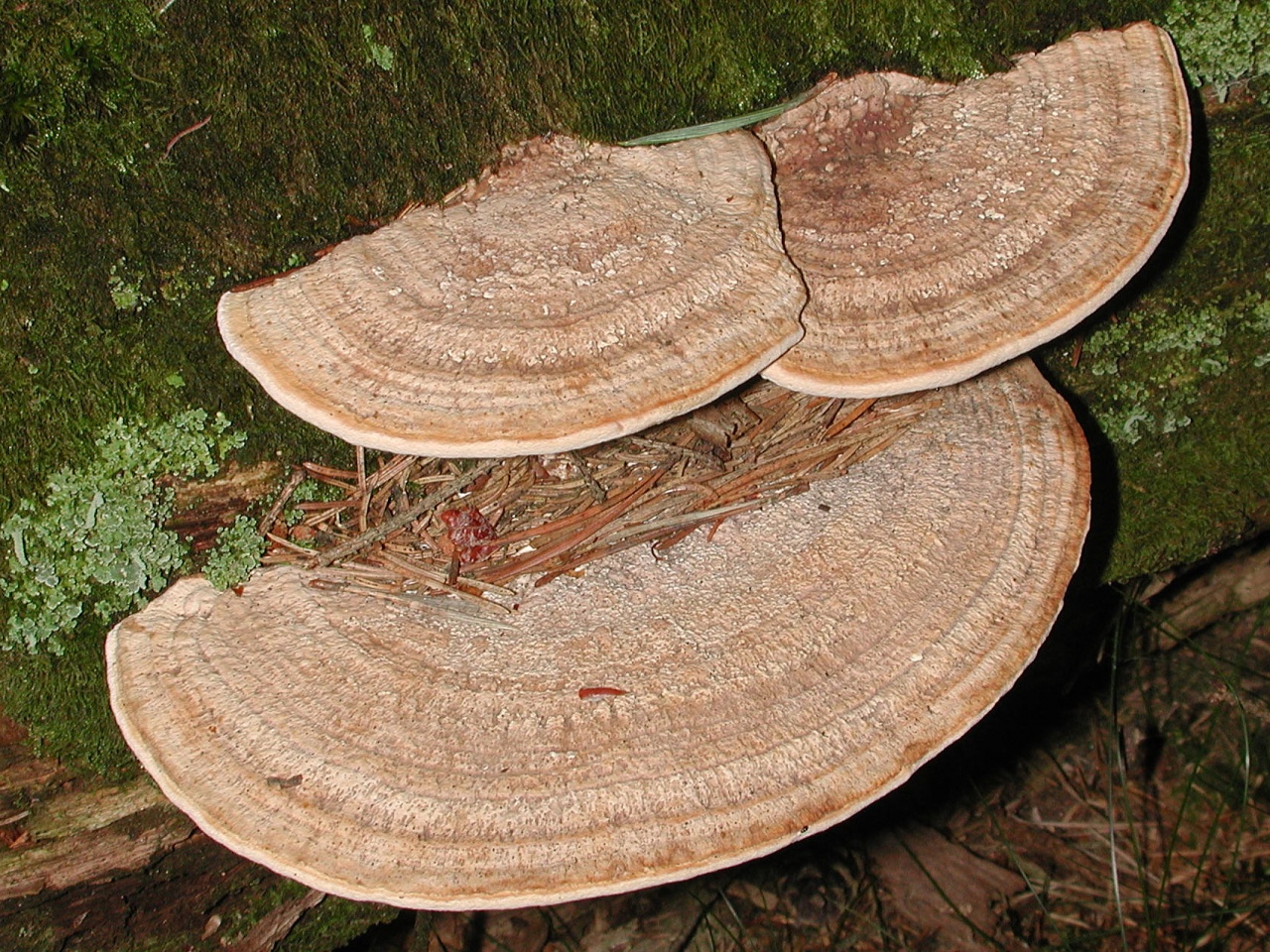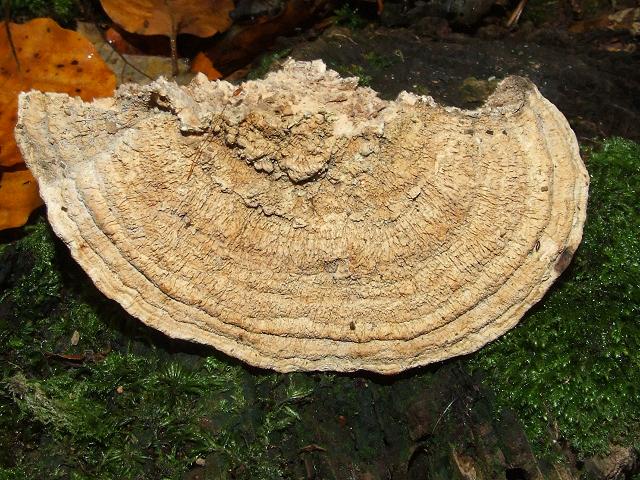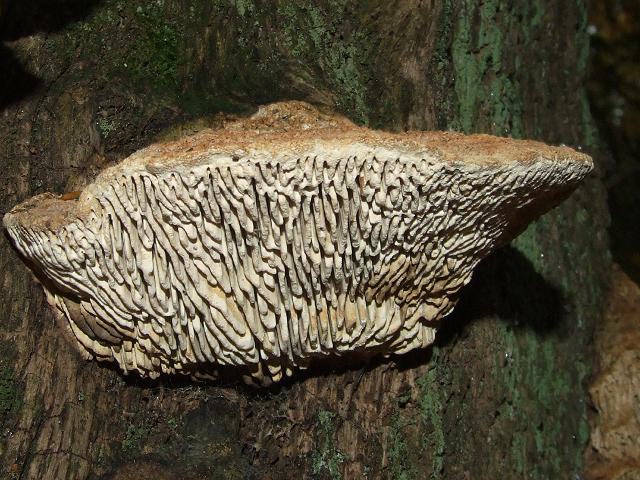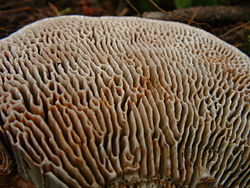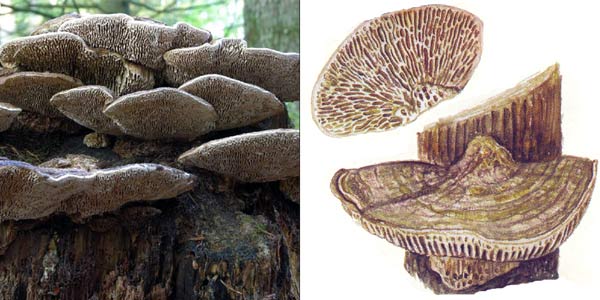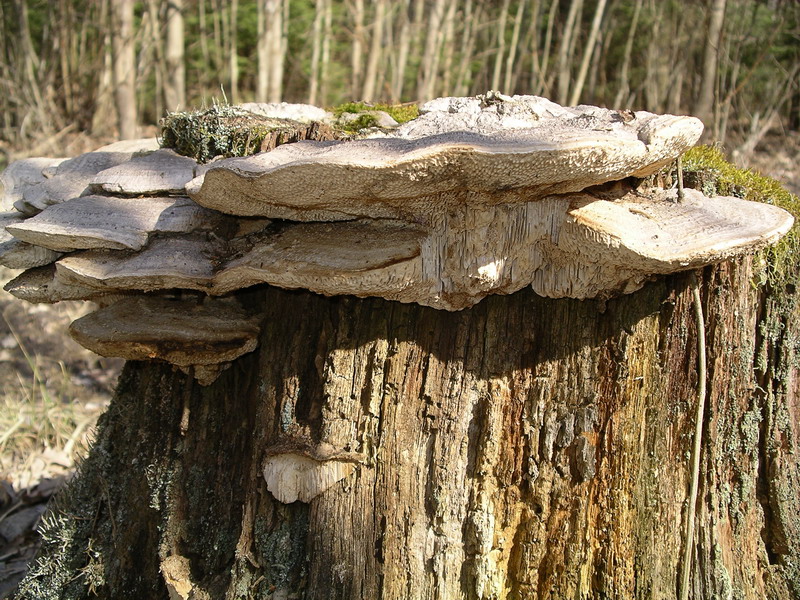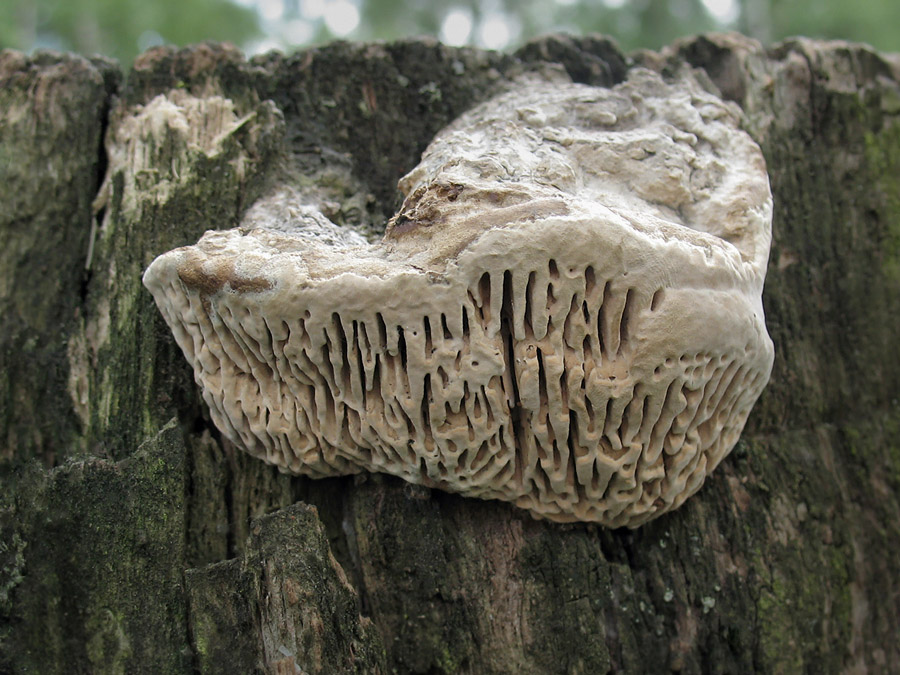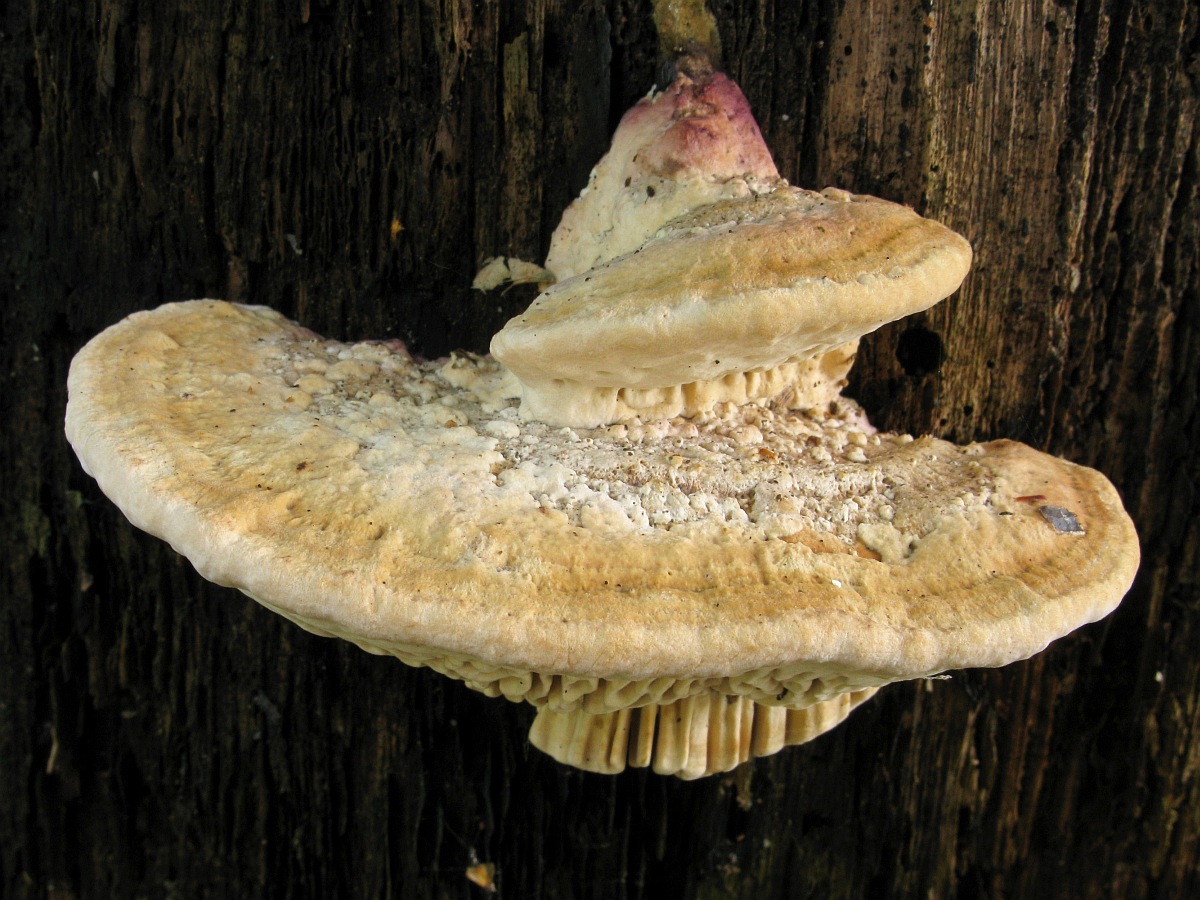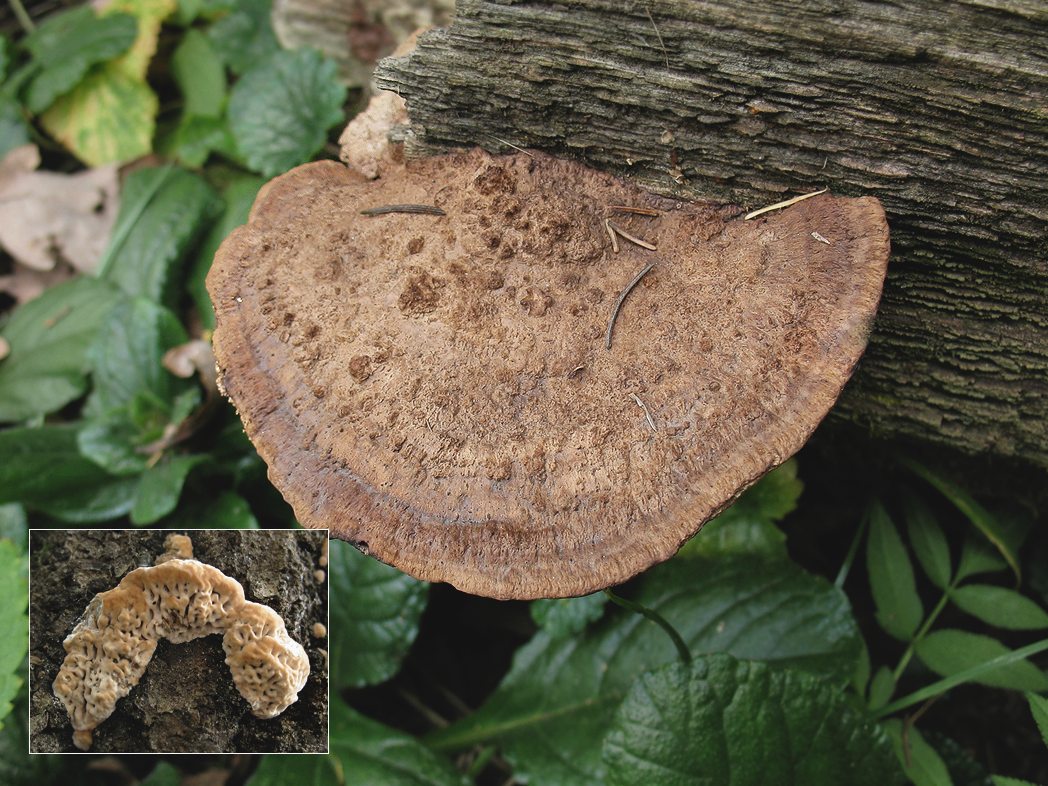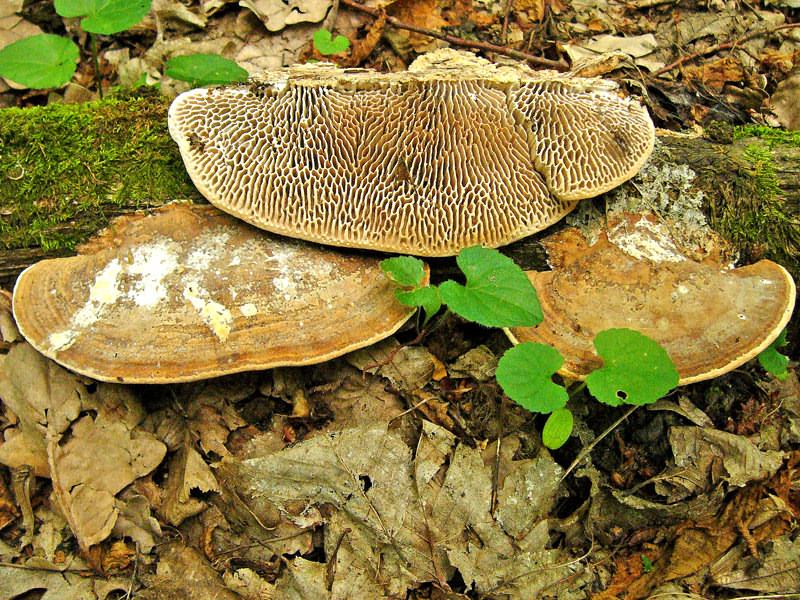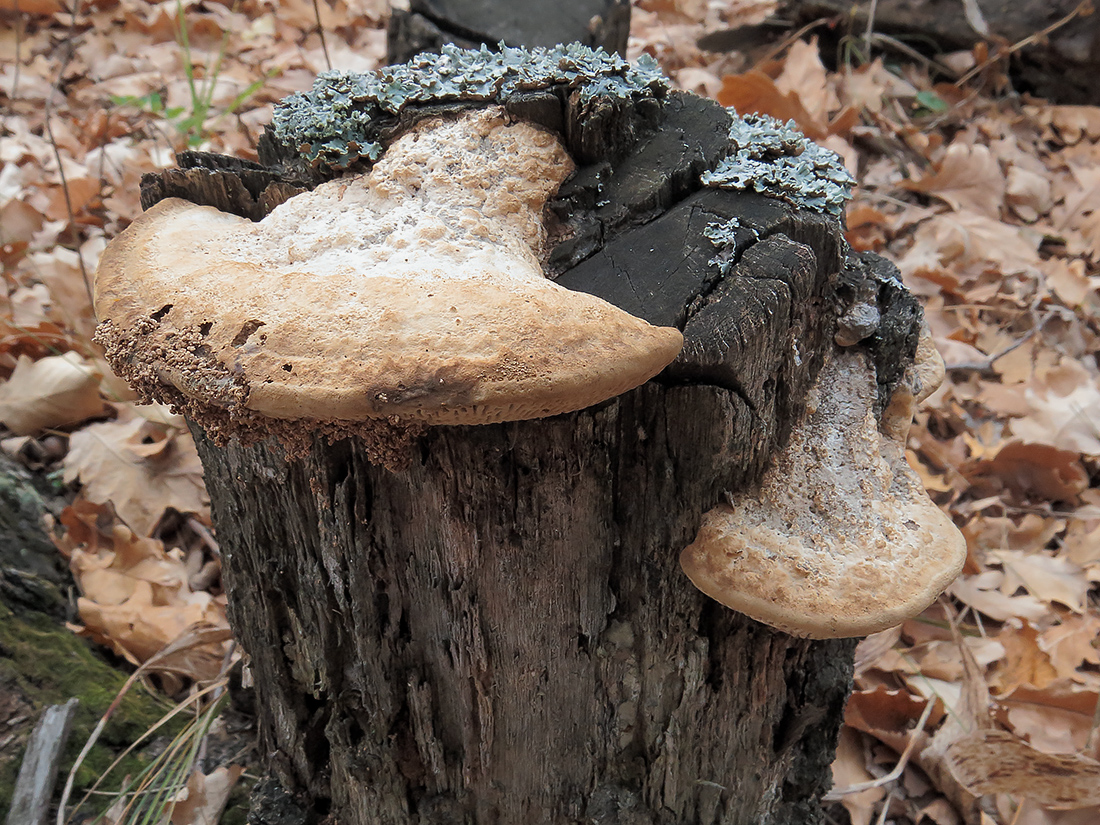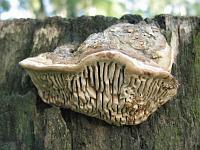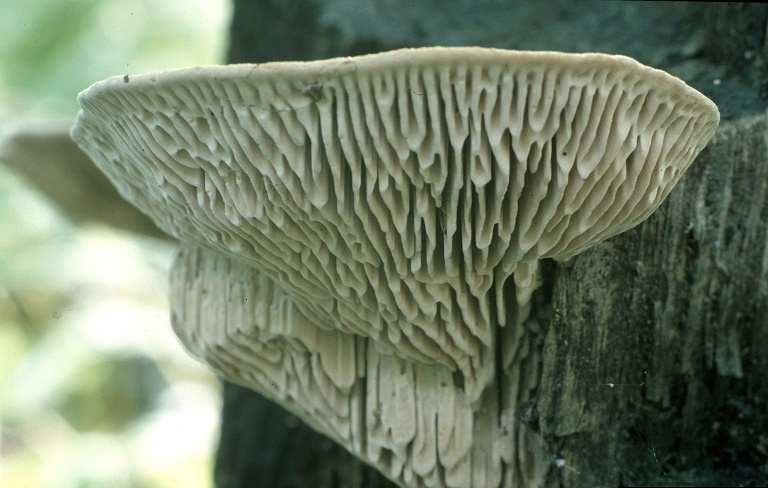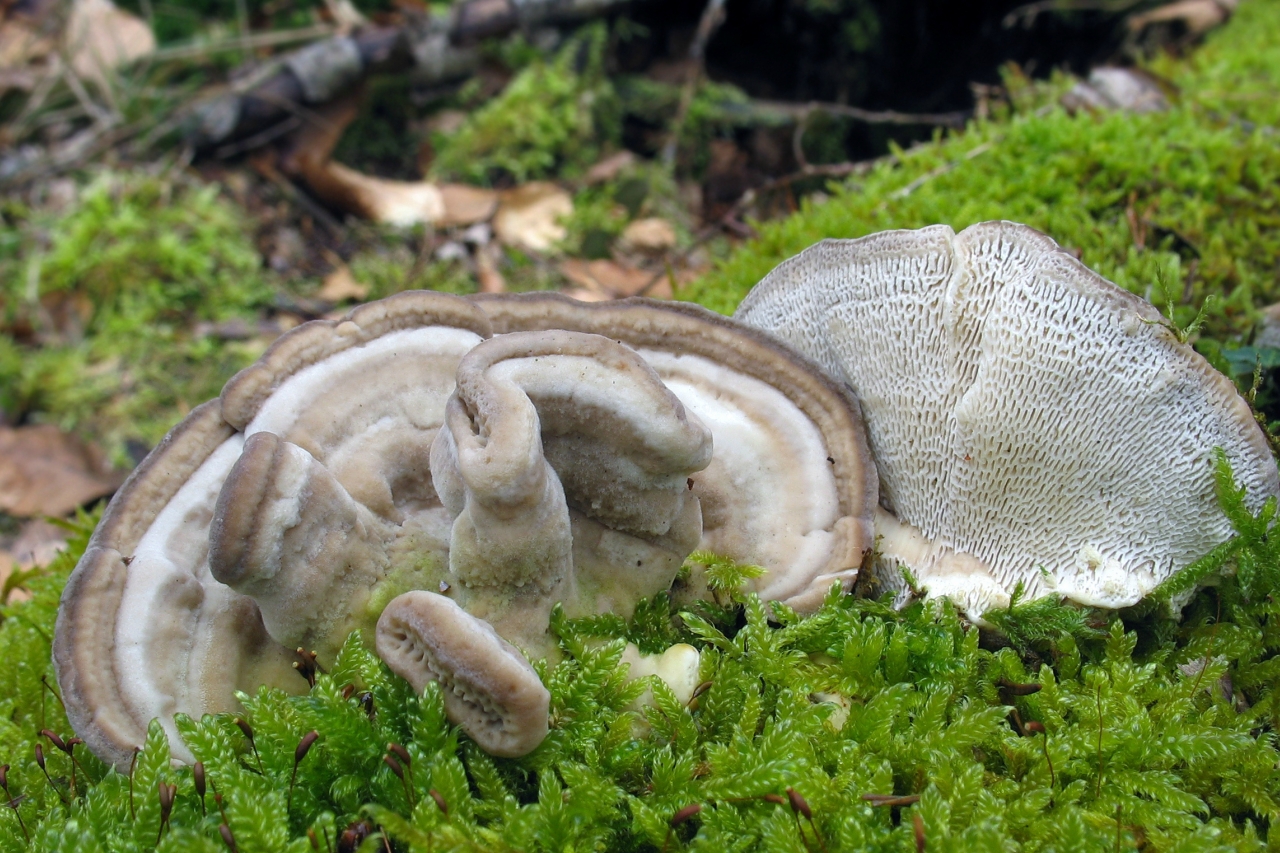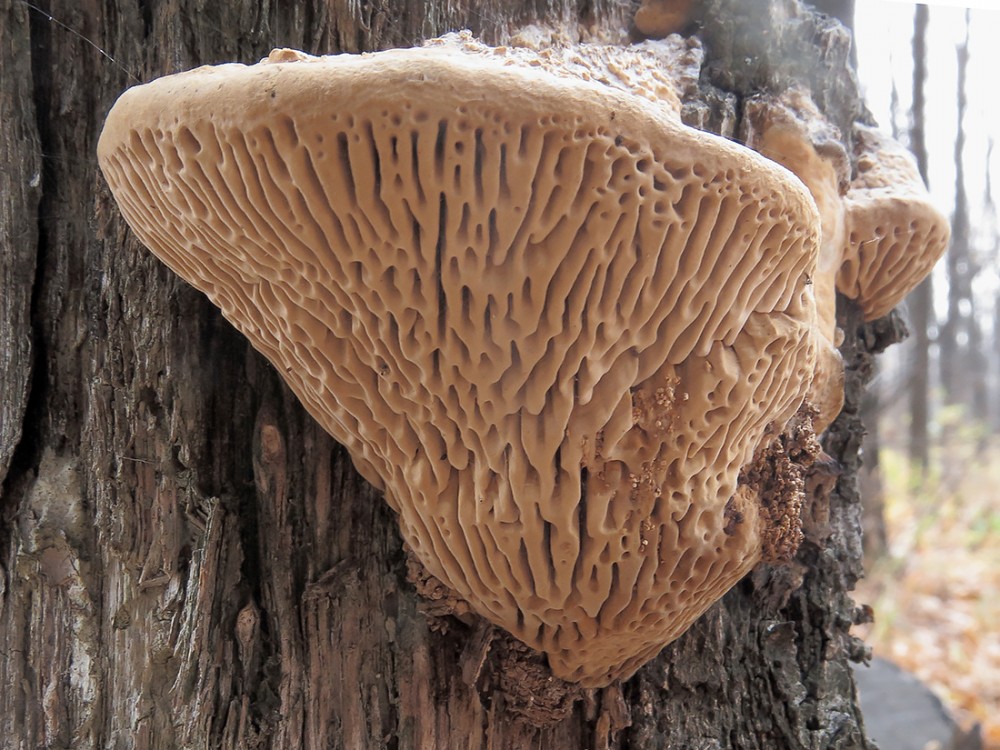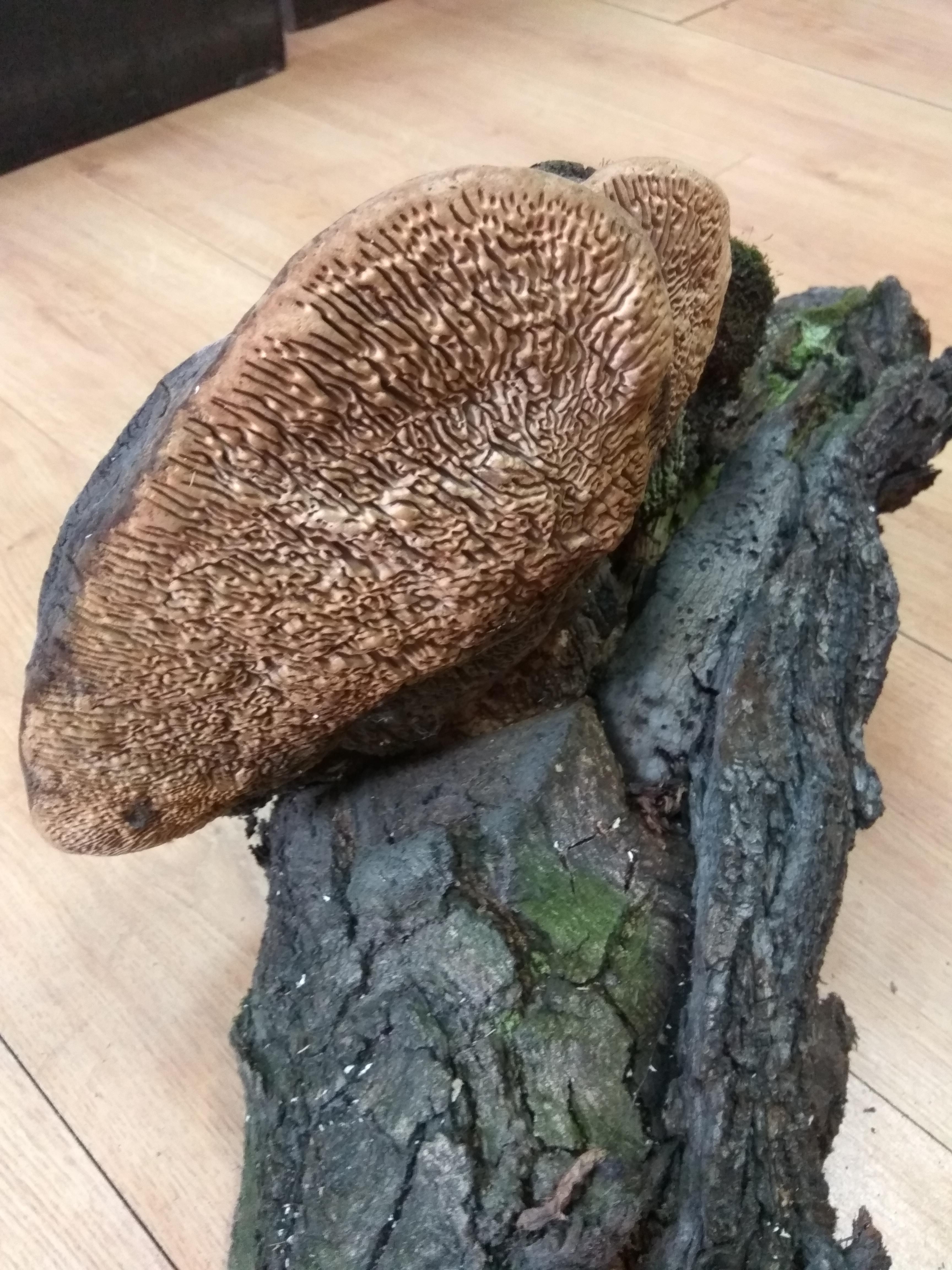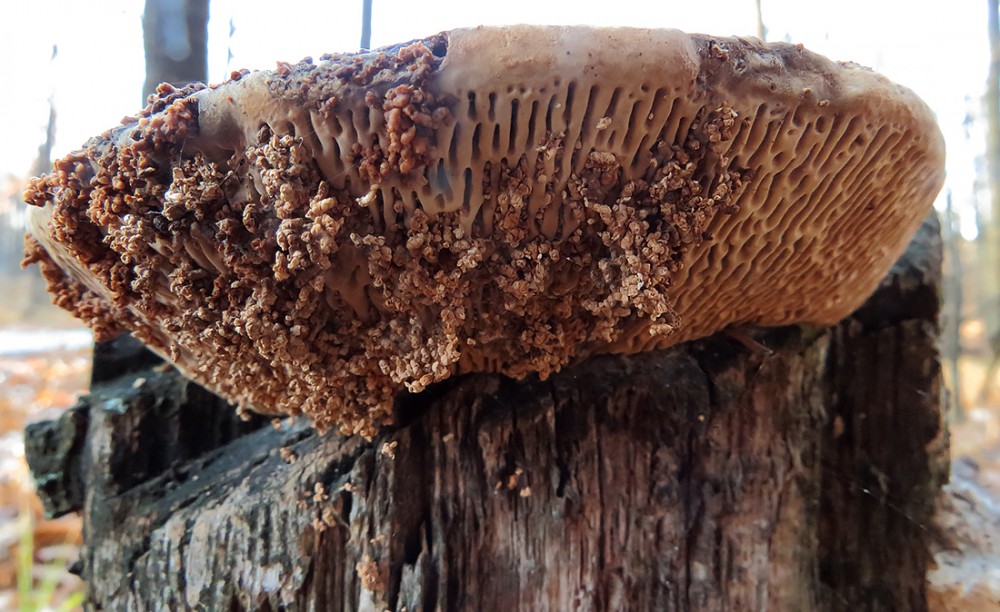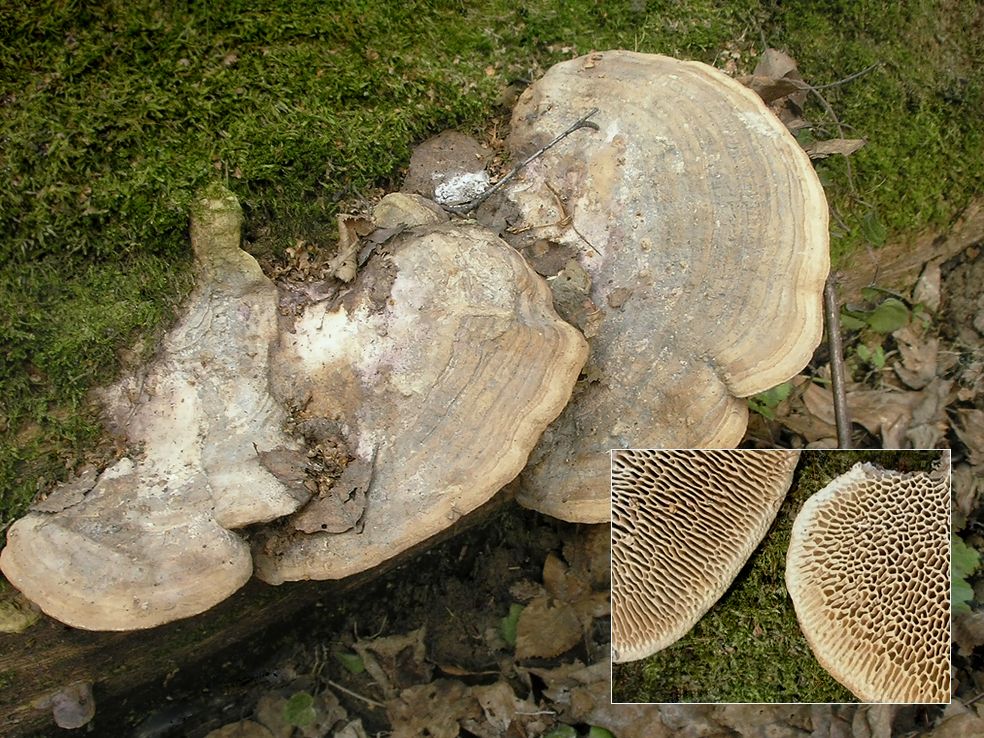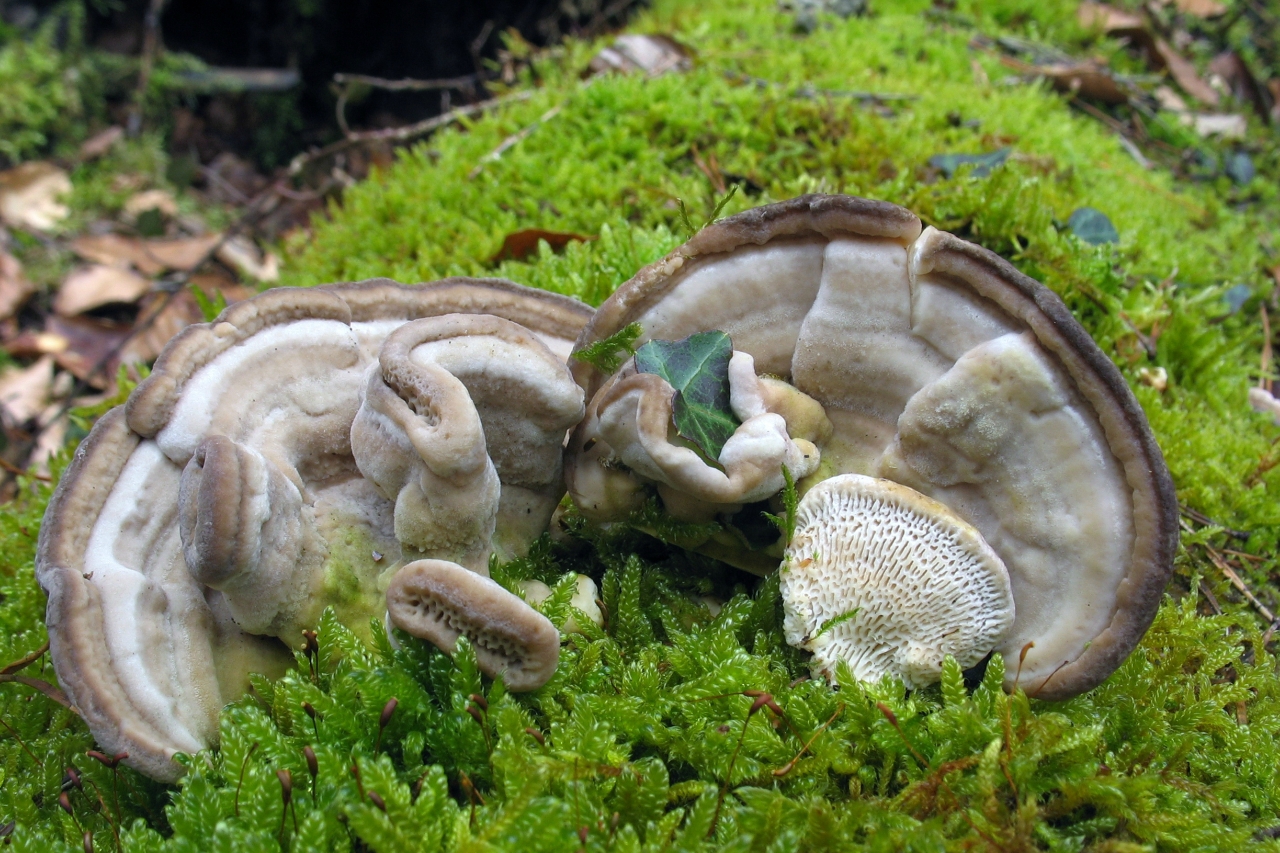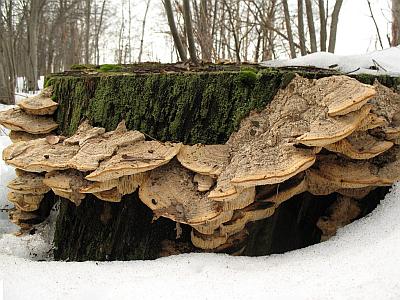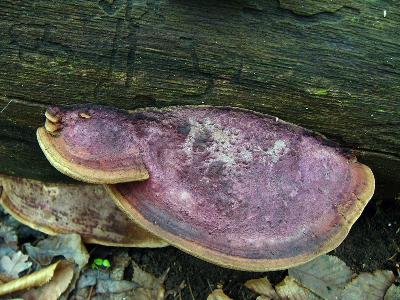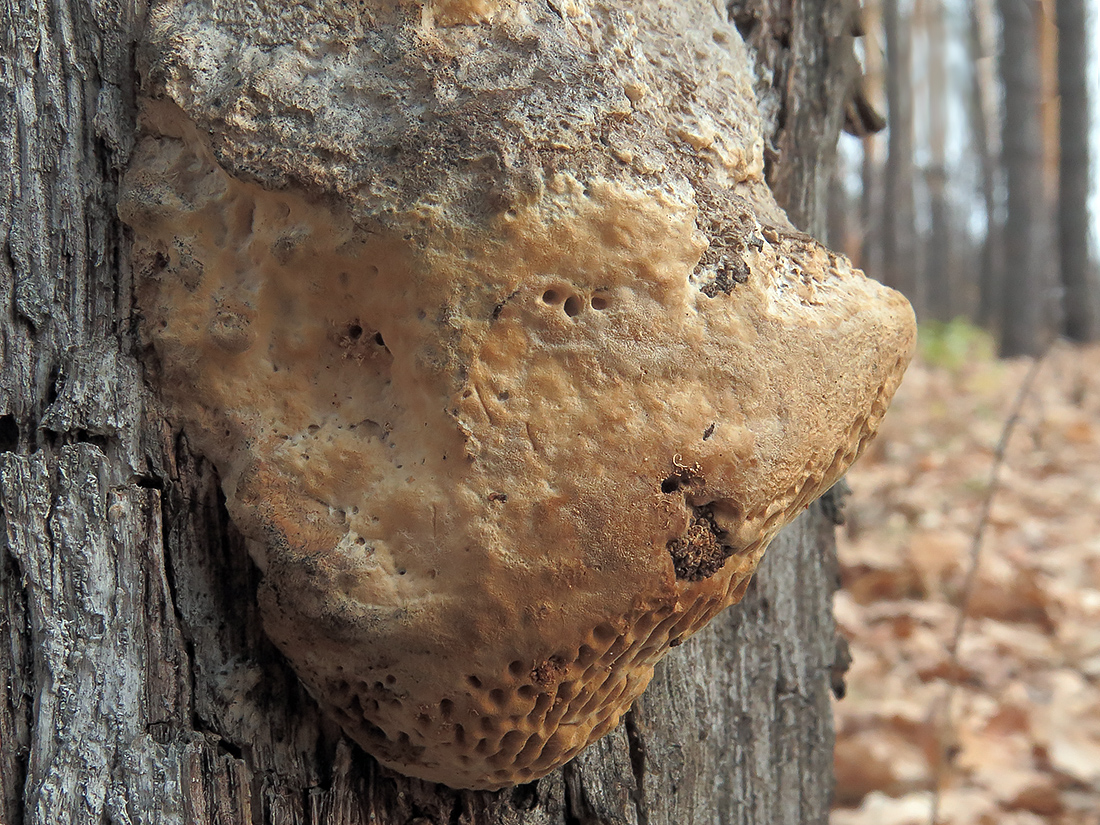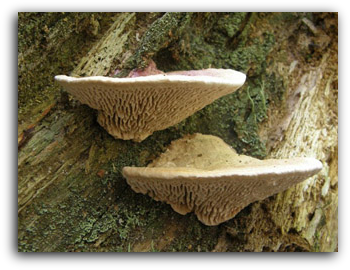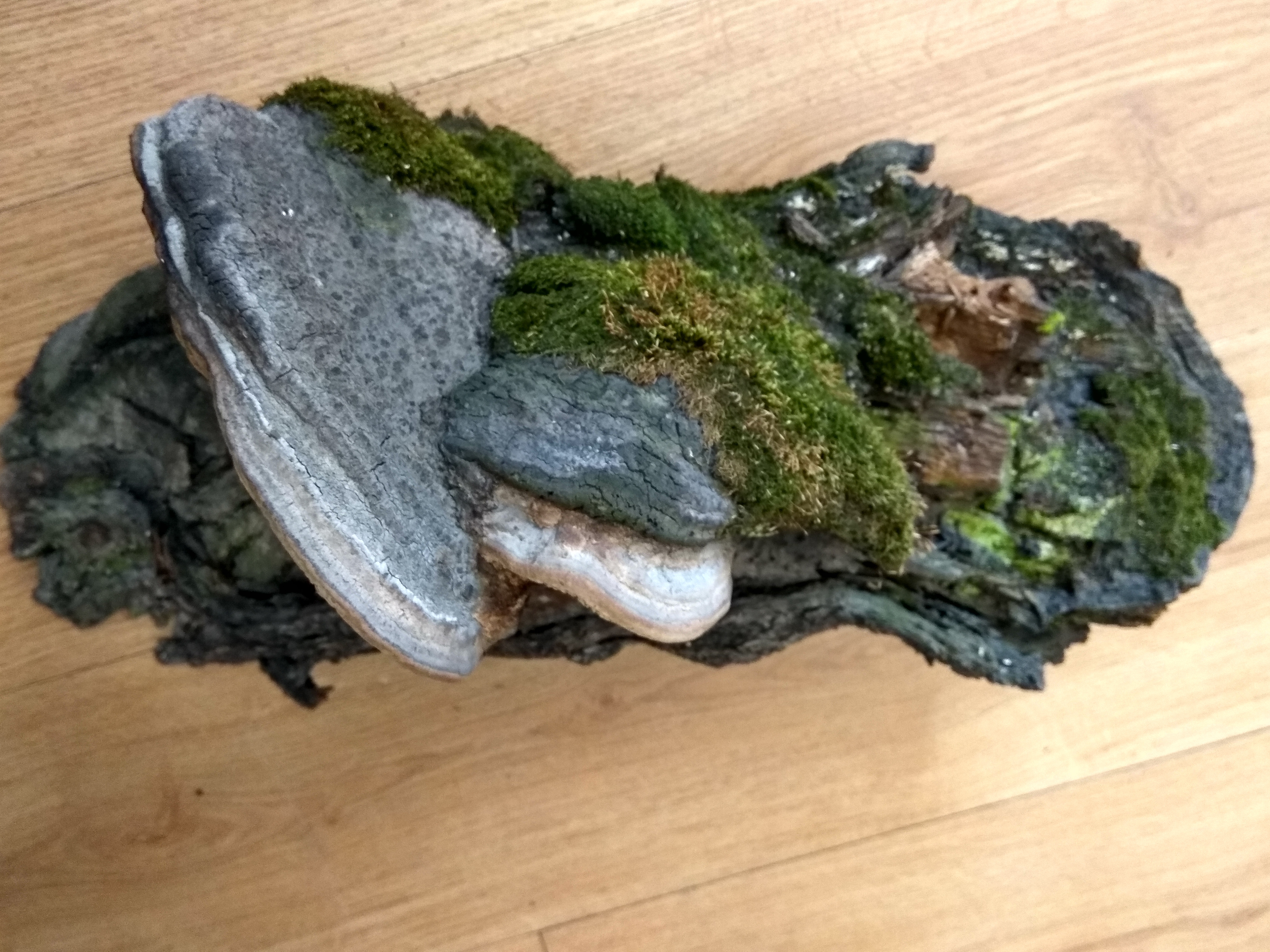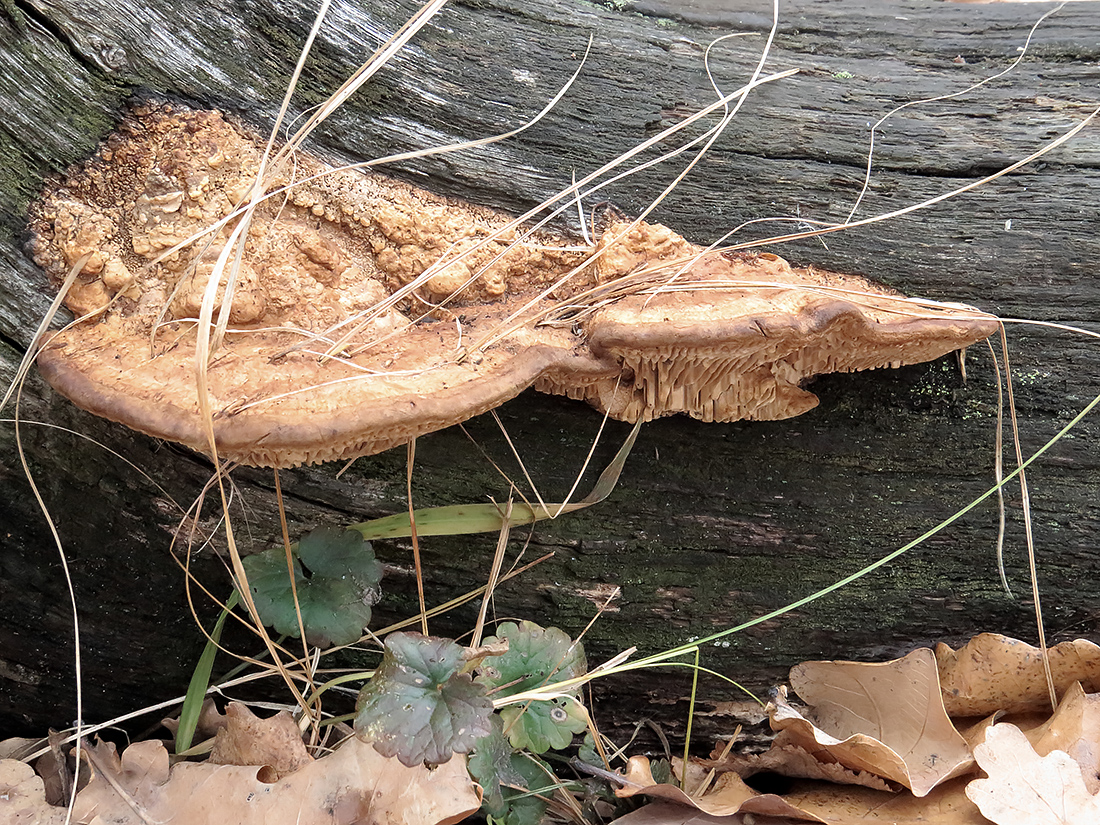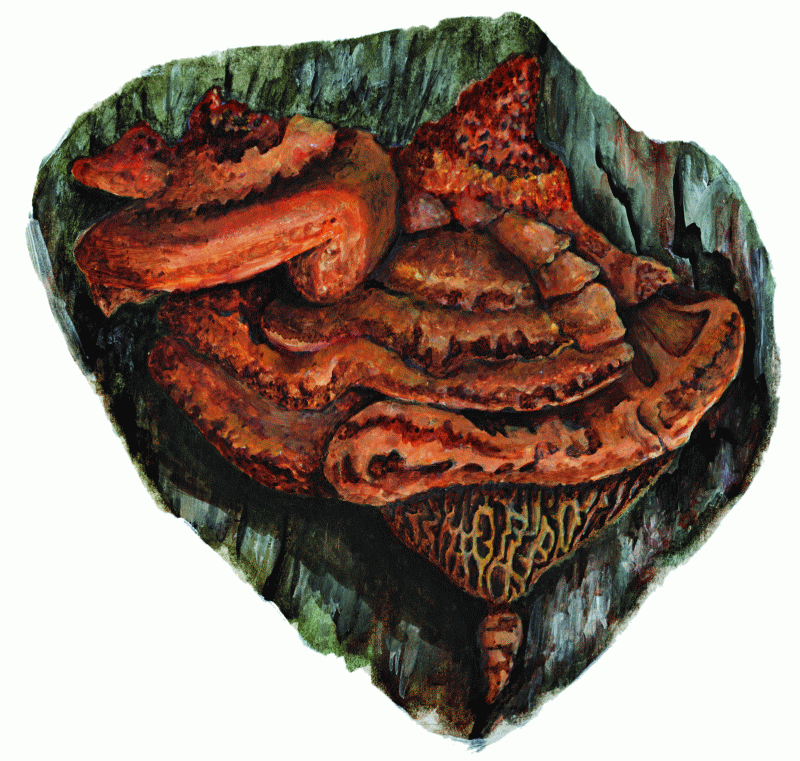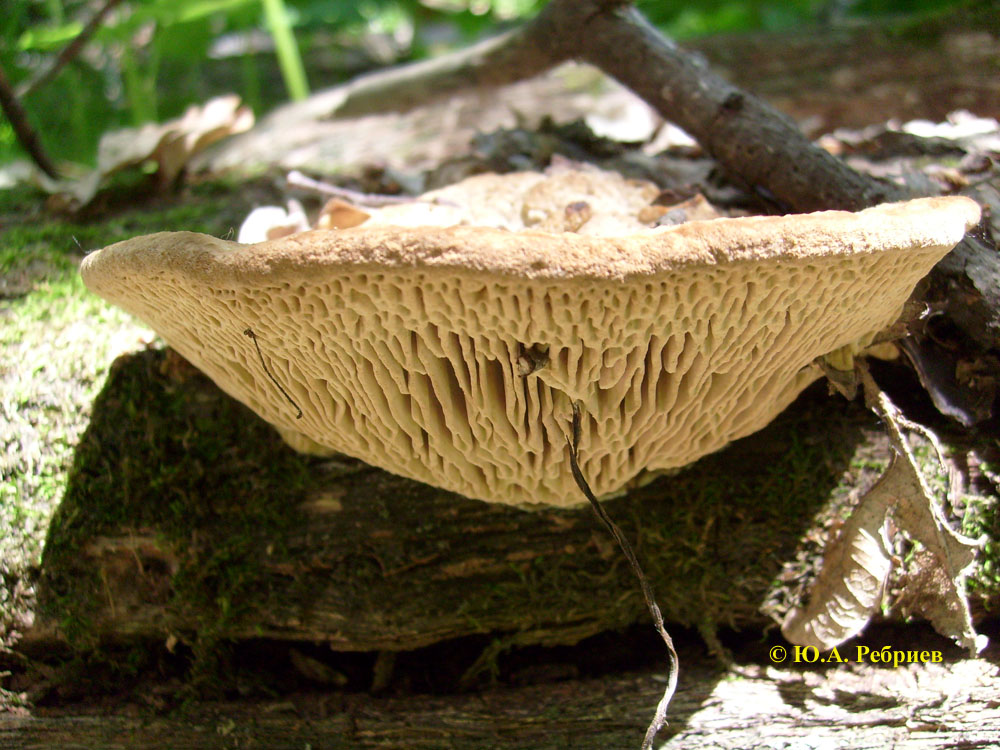Influence of external factors
The development of xylotrophs and their wood-destroying activity are influenced by environmental factors. The mycelium of xylotrophs is located deep in the tissues of wood and, due to its poor thermal conductivity, is well protected from the negative effects of high and low temperatures and their sharp fluctuations.
Depending on the types of fungi, their mycelium (mycelium) can develop within the range from 0 to +46 ºС. The moisture requirements of various xylotrophs are also not the same, but most rot pathogens develop normally at a sufficiently high constant moisture content in the wood. This is ensured by the high moisture content of the wood of growing trees and the high water-absorbing capacity of the pathogens basidiomas.
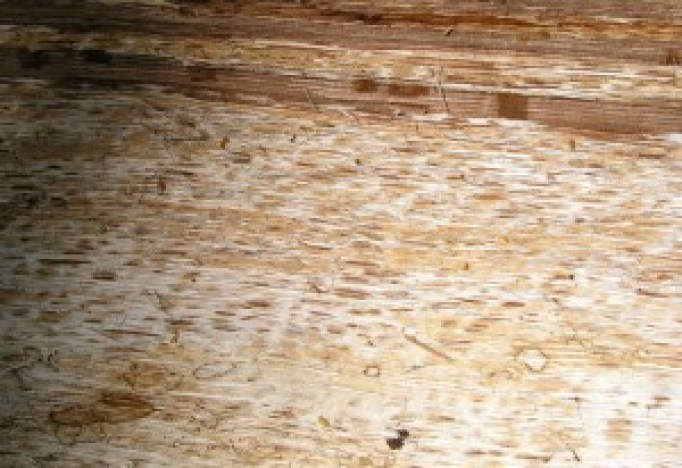
Corrosive rot of the oak tinder fungus
The rate of decay and the rate of spread of rot depends on the biological characteristics of the causative agent of rot and the affected species, the conditions for their development, and the technical qualities of wood. However, there is no connection between these indicators. For example, spruce sponge and oak-tinder fungus cause rapid decay of wood, but rot in the spruce trunk from a spruce sponge spreads very quickly, and oak rot caused by oak-tinder fungus spreads slowly.
Oak sponge (Daedalea quercina)
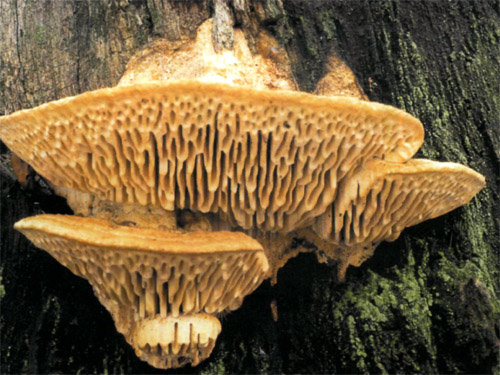
Hat:
The Oak Sponge's hat grows to an impressive size. Its diameter can reach ten to twenty centimeters. The hat has a hoof-like shape. The top side of the cap is painted white-gray or light brown. The surface of the cap is uneven; there is an external, prominent, thin edging. The cap is bumpy and rough, with concentric grooves in a woody color.
Pulp:
the flesh of the Oak Sponge is very thin, corky.
Tubular layer:
the tubular layer of the fungus grows in thickness up to several centimeters. The pores are barely visible, visible only along the edges of the cap. Painted in a pale woody color.
Spreading:
Oak Sponge is predominantly found on oak trunks. Sometimes, but rarely, it can be found on the trunks of chestnuts or poplars. Bears fruit all year round. The mushroom grows to enormous size and grows over several years. The fungus is common in all hemispheres, it is considered the most common species. It grows wherever there are suitable conditions. On living trees, it is very rare. The fungus causes the formation of sound brown rot. Rot is located in the lower part of the trunk and rises to a height of 1-3 meters, sometimes it can rise up to nine meters. In forest plantations, the Oak Sponge does little harm. This mushroom inflicts more damage when storing felled wood in warehouses, in buildings and structures.
Similarity:
Oak Sponge in appearance strongly resembles the same inedible mushroom - Polypore Bumpy. It is distinguished by the fact that the thin fruiting bodies of the Tinder fungus, when fresh, turn red when pressed. The mushroom is easy to recognize due to its characteristic place of growth (dead and living branches and stumps of oak), as well as the special, labyrinthine structure of the tubular layer.
Edibility:
the mushroom is not considered a poisonous species, but it is not eaten because it has an unpleasant taste.
Note: On old oak stumps, a rather attractive Polypore grows, the surface of which is painted in ocher color. Instead of pores, this fungus has elongated labyrinth-like cells, which is its main distinguishing feature. Large fruiting bodies, semicircular in shape, widely grown with a warty or furrowed surface. In the middle, the fruit bodies are cork-shaped, yellow-ocher color.The mushroom has been growing for several years. It settles on dead trunks of oak, beech or chestnut. It can also grow on treated wood. The Oak Sponge is found everywhere, a common, common mushroom. It causes a rapidly developing rot, brown in color, which further disintegrates into radial plates.
Biological description
Fruit bodies are three to four years old, without legs, sometimes almost prostrate, half, saucer-shaped, thick, up to 15-20 cm in diameter and up to 8 cm thick. The upper surface of the cap is flat-convex, usually with a slight elevation at the base, glabrous or covered with fine pubescence, cream, brownish or smoky grayish. The edge of the cap is sharp or dull, with an ocher tinge. The pulp is corky-woody, ocher-yellow.
Typical hymenophore in the form of a labyrinth.
The hymenophore consists of tubules, at the edge almost rounded, closer to the base - lamellar and forming a labyrinth. The pore walls are 1-3 mm thick, the pores themselves are 1-4 mm in diameter. The color of the hymenophore is light brownish, sometimes a whitish coating is observed on it.
The hyphalous system is trimic. Hymenophore hymenophores (generative) thin-walled, with buckles, branched, unpainted. Hyphae trams (skeletal) thick-walled or completely solid, aseptic, protruding above the surface of the hymenophore like cystids. The connecting hyphae are highly branched, thick-walled, golden yellow. Cystyds are absent. Basidia are clavate, four-spore. Spores are cylindrical or narrowly elliptic, colorless, non-amyloid, 5.5-7.5 × 2.5-3.5 microns.
Due to its very tough cork-like consistency, the oak sponge is classified as an inedible mushroom.
Similar views edit code
Several unrelated species of polypores can be confused with dedalea. Species of the genus Gleophyllum are distinguished by a darker surface of fruit bodies and brown flesh. Rough Dedaleopsis can be very similar to Dedalea, however, it differs in less regular pores, usually turning brown when damaged.
Destruction of wood
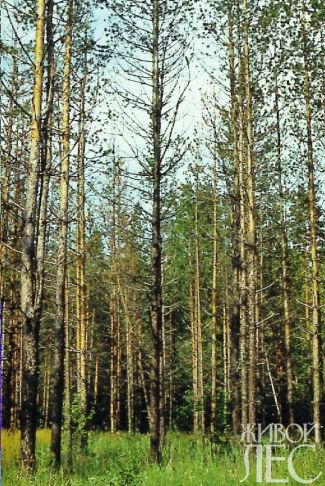
Drying of trees in the foci of the root sponge
Rotting wood is the process of its decomposition and destruction by wood-destroying fungi using a specific set of enzymes (substances that convert complex organic compounds into water-soluble, easily digestible by the fungus).
The nature of the destruction depends on the type of fungus and its set of enzymes, the degree and sequence of its destruction of cell walls, changes in the chemical composition of wood pulp and its physical properties. There are destructive and corrosive types of decay.
In the destructive type, decomposition of cellulose and hemicellulose occurs, which are the main constituent part of the cell walls and provide mechanical strength and elasticity of wood tissues. The cell membranes are destroyed evenly, gradually, without the formation of large holes in them. The fungus affects the entire mass of wood. As a result, the entire volume of the wood decreases, numerous cracks appear in it. Subsequently, the wood disintegrates into prismatic pieces, becomes brittle, and is easily ground into powder. The color of the wood is also gradually changing. At first, it becomes reddish, later turns brown, and in the final stage it acquires a dark brown color. Rot of this type is caused by the Swiss tinder fungus, sulfur-yellow tinder fungus, bordered tinder fungus, larch sponge and birch sponge, etc.
With a corrosive type of decay, lignin (an organic compound that causes lignification of the cell walls) and partially the cellulose complex are destroyed. Some fungi simultaneously decompose lignin and cellulose, destroying groups of cells in separate places. In the affected wood, cavities appear in the form of pits and cells, filled with white undecomposed cellulose.White spots of cellulose on a brown wood background create a variegated rot color (variegated corrosive rot). Variegated corrosive rot are caused by a root sponge, a pine sponge and a sponge sponge, a spruce butt tinder fungus and an oak tree tinder fungus.
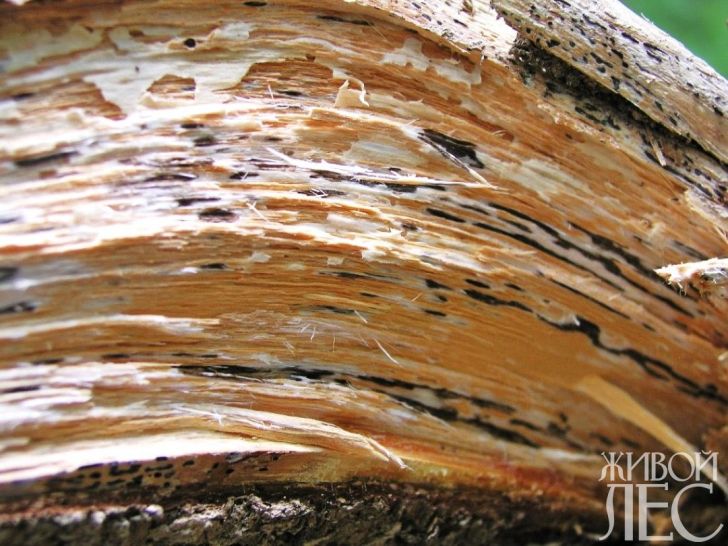
Corrosive rot from root sponge
Other types of fungi initially completely decompose lignin, and then cellulose and other polysaccharides are gradually destroyed. At the same time, in the final stage of decay, the affected wood brightens evenly or in stripes, acquires a white, light yellow or "marble" color (white corrosive rot). White corrosive rot is caused by autumn honey fungus, real tinder fungus, false tinder fungus, flat tinder fungus.
Root rot is the most dangerous for growing trees, causing them to weaken, dry out, and reduce resistance to wind.
In the case of a corrosive type of decay, not all of the wood mass is decomposed: individual groups of destroyed cells alternate with untouched areas of wood. Therefore, at different stages of wood destruction, rot acquires a pitted, pitted-fibrous, fibrous structure. The wood splits into fibers, crumbles, retains its viscosity, and its volume does not decrease.
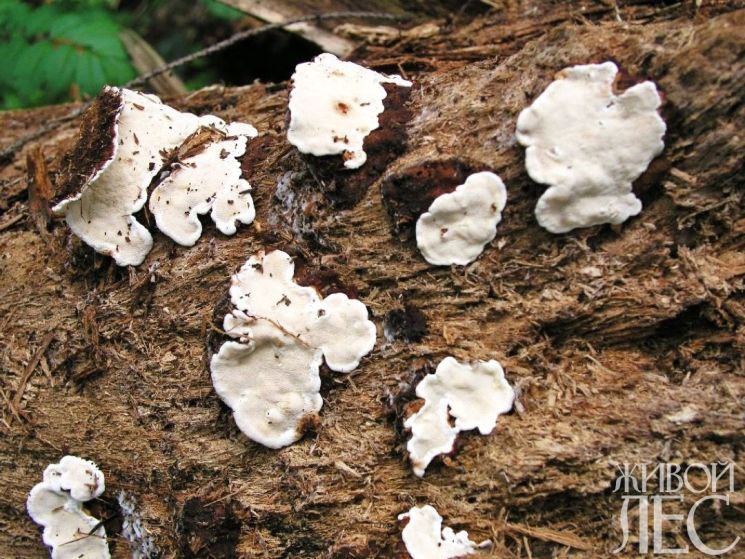
Fruit bodies of the root sponge
Taxonomy
Daedalus oak was first described by Karl Linnaeus as a collective genus of lamellar mushrooms. In 1801, the famous Dutch mycologist Christian Hendrich Person in the book Synopsis methodica fungorum singled him out to a new genus Daedalea... The generic name comes from the name of the hero of ancient Greek myths, Daedalus, who built a labyrinth in Knossos, in which the Minotaur lived. Elias Magnus Fries Systema mycologicum this name was adopted.
Synonyms edit code
- Agarico-suber daedaleum Paulet, 1793
- Agaricus antiquus Willd., 1787
- Agaricus dubius Schaeff., 1774
- Agaricus quercinus L., 1753basionym
- Agaricus labyrinthiformis Bull., 1788, nom. superfl.
- Antrodia hexagonoides (Quél.) P. Karst., 1879
- Daedalea nigricans Pers., 1801
- Daedalea inzengae Fr., 1869
- Daedaleites quercinus (L.) Mesch., 1892
- Hexagonia minor Lázaro Ibiza, 1916
- Lenzites quercinus (L.) P. Karst., 1882
- Lenzites quercinus f. trameteus Bourdot & Galzin, 1925
- Merulius quercinus (L.) J.F. Gmel., 1792
- Striglia inzengae (Fr.) Kuntze, 1891
- Striglia quercina (L.) Kuntze, 1891
- Trametes hexagonoides Quél., 1872
- Trametes quercina (L.) Pilát, 1939
- Trametes quercina f. minutipora Pilát, 1939
- Trametes quercina f. mycelium-sterile Pilát, 1939
Fruiting bodies - basidiomas
Basidiomas of causative agents of rot are distinguished by a wide variety of shape, surface color, consistency, color and density of internal tissue, types of hymenophore (part of the fruiting body on which sporulation organs are formed). It can be tubular, lamellar, labyrinthine (dedalea), needle-like, etc. For example, in a real tinder fungus (Fomes fomentarius), the hymenophore is tubular, in the autumn mushroom (Armillaria mellea) - lamellar, in an oak sponge (Daedalea quercina), labyrinthine in the northern climacodon (Climacodon septentrionalis) - needle-like.

North climacodon
Fruit bodies can be perennial and annual:
in perennial basidiomas, an annual growth of the hymenophore occurs in the form of clear layers, such as in the false tinder fungus (Phellinus igniarius) and the bordered tinder fungus (Fomitopsis pinicola), pine sponge (Porodaedalea pini), etc.

Edged tinder fungus
annual fruiting bodies always have one hymenophore layer. In old age, annual basidiomas harden or rot. Examples of the former are the fruiting bodies of the birch sponge (Piptoporus betulinus); sulfur-yellow tinder fungus (Laetiporus sulphureus); oak tinder fungus, or oak-loving (Inonotus dryophilus); scaly tinder fungus (Polyporus squamosus). Decaying fruiting bodies are characteristic of autumn mushrooms, oily scales (Pholiota adiposa), oyster mushrooms (Pleurotus ostreatus).
 Scaly tinder fungus
Scaly tinder fungus 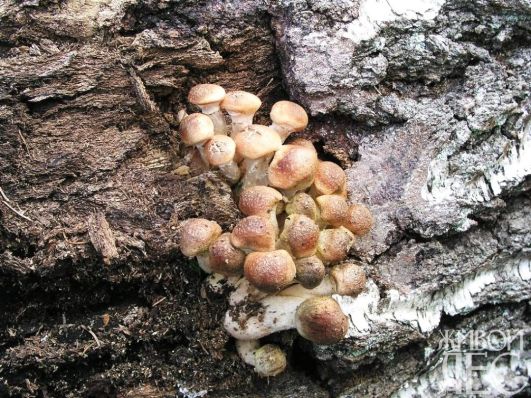 Fruiting bodies of the honey fungus on the affected trunk
Fruiting bodies of the honey fungus on the affected trunk
Hoof-shaped mushrooms
Polypore cinnabar red (Pycnoporus cinnabarinus).
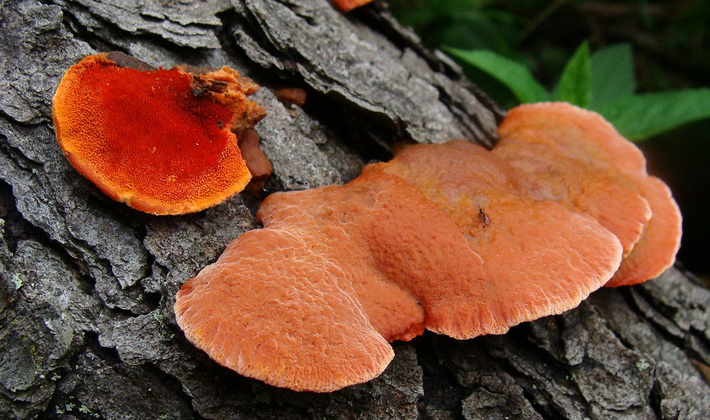
Family: Bondarzewiaceae.
Season: summer - autumn.
Overgrowth: often several mushrooms grow attached together, on top of each other
Description:
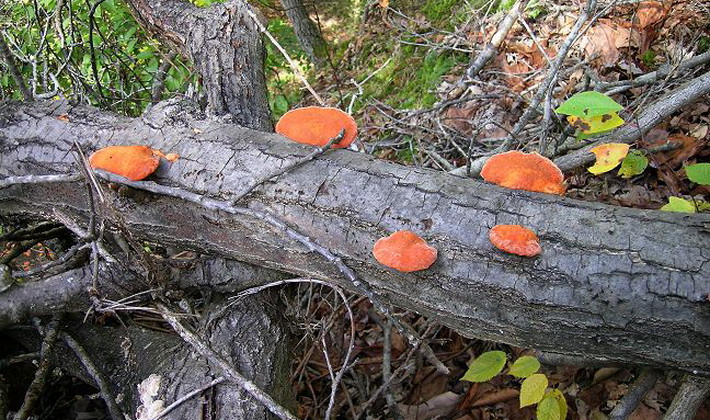
The fruiting body is annual, hoof-shaped and almost rounded.

The pulp is red, corky.
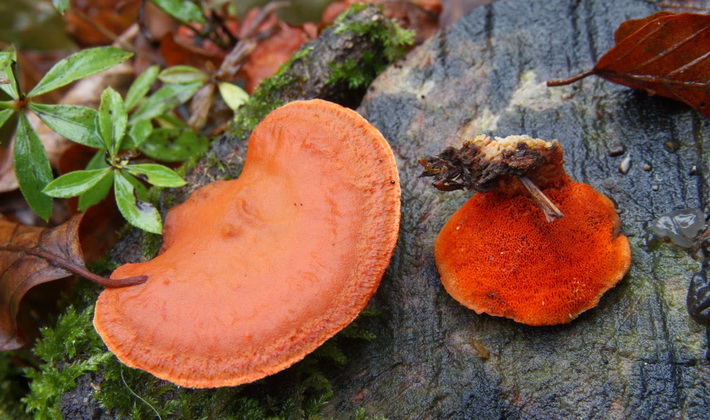
The surface of young specimens is bumpy, bright red, smoothes and fades with age. The hymenophore is tubular, carmine-red; pores of medium size.
Inedible.
Ecology and distribution:
It grows on decaying deciduous wood (especially birch), less often on weakened living trees.
True polypore (Fomes fomentarius).
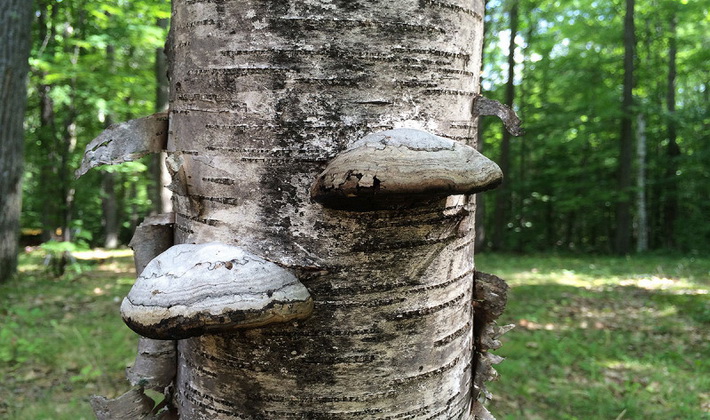
Family: Polyporous (Polyporaceae).
Season: all year round.
Growth: singly and in groups.
Description:
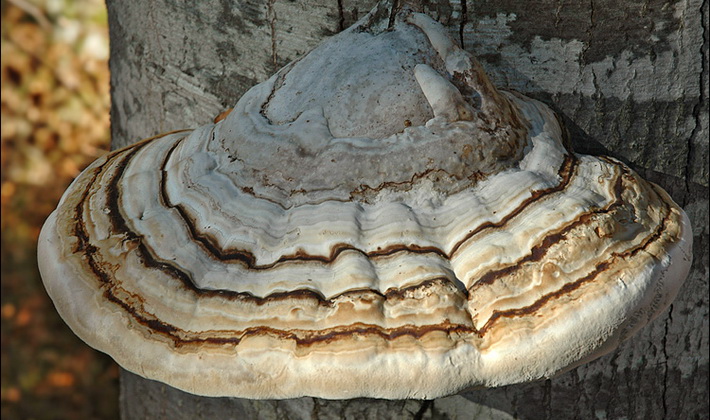
The surface is lumpy, matte, with concentric ridges, covered with a woody crust of gray tones.

The tubular layer is finely porous, even, whitish or grayish, darkens from touch. Fruit body, perennial, hoof-like.
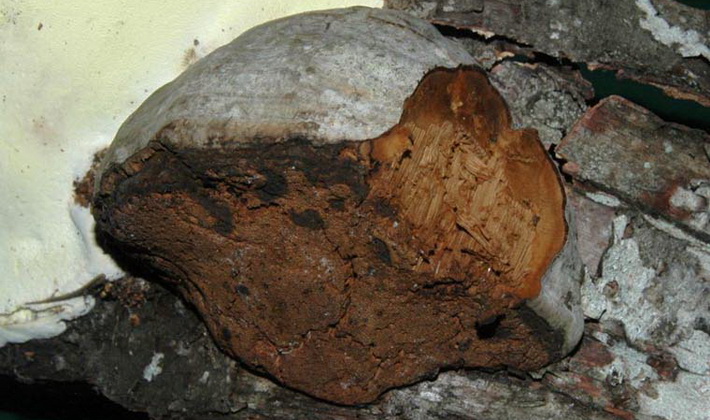
The pulp is corky or woody, brown.
Inedible. In the past, it was used as a raw material for tinder.
Ecology and distribution:
Grows on deciduous trees (birch, aspen, alder, oak, beech and others). Most often it appears on dead, dead trees and stumps, but it can also infect weakened living trees.
Oak sponge (Daedalea quercina).
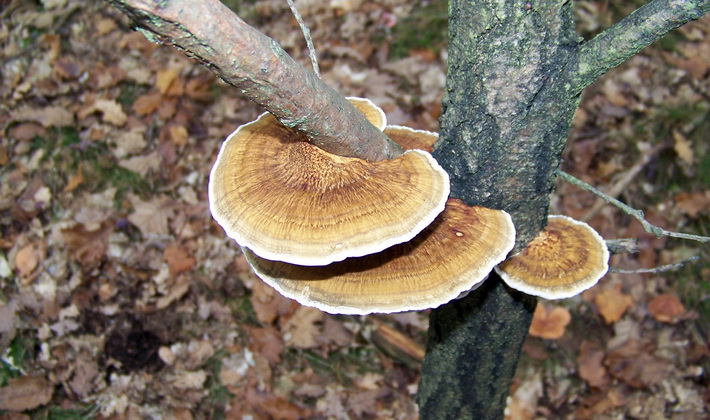
Family: Fomitopsis (Fomitopsidaceae).
Season: all year round.
Growth: in tiled groups.
Description:
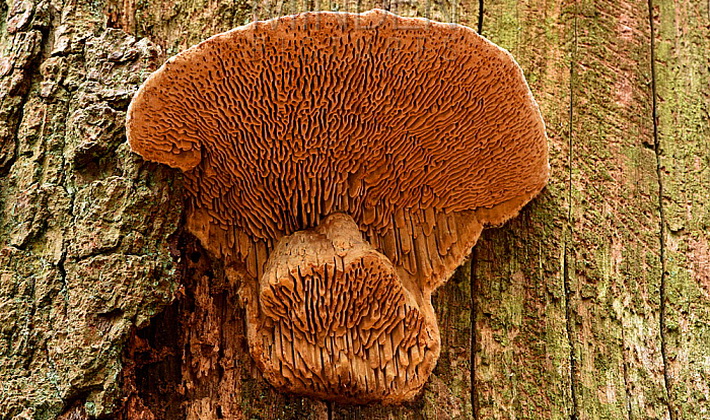
The pulp is yellowish-beige, cork, with a harsh or mushroom odor.
Gimenophore labyrinthine beige or sandy color. The pores are large, irregular, pseudo-lamellar structure.
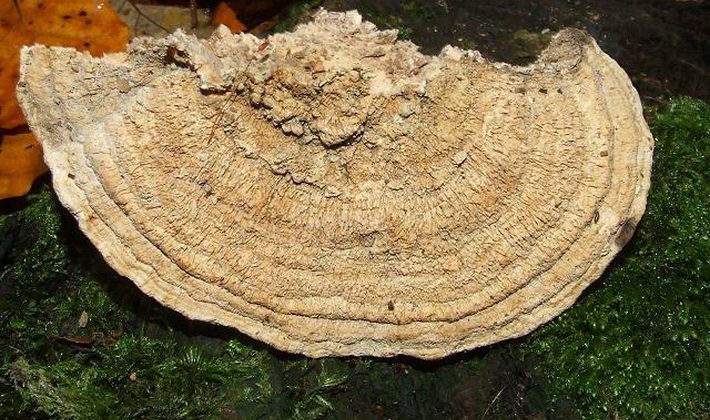
The surface is uneven, lumpy or wrinkled, sometimes with concentric grooves, naked, yellowish-gray, beige or sandy in color.
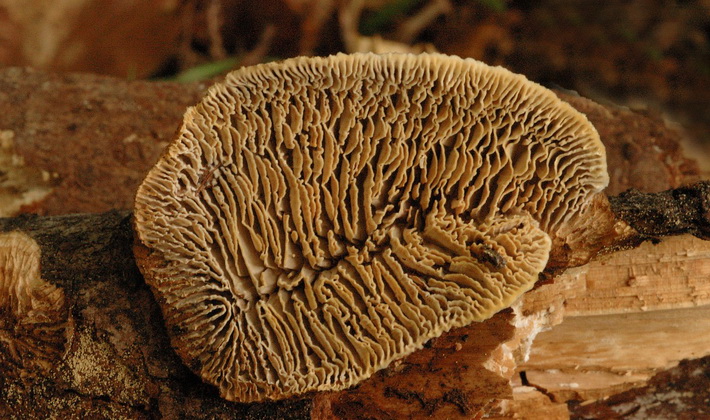
The fruiting body is perennial, hoof-shaped with a thickened base and a relatively thin edge.
Inedible. A decoction of the mushroom is used in folk medicine in the treatment of hepatitis.
Ecology and distribution:
It grows on stumps and dead trunks of broad-leaved species (oak, beech, chestnut), as well as on processed wood: piles, sleepers, poles. It is extremely rare on living trees.
Check out what the hoof-shaped mushrooms look like in these photos:

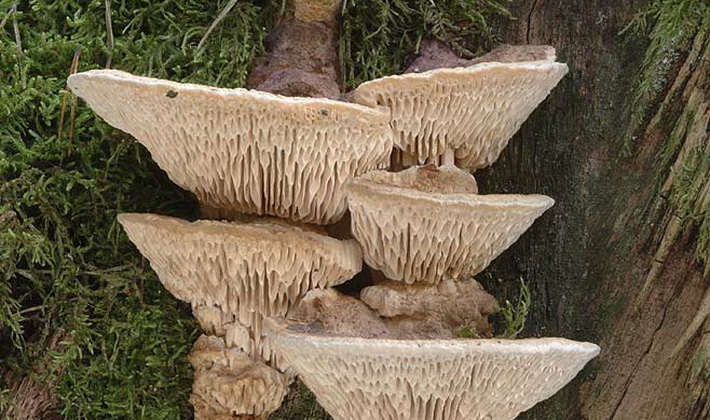

Share article:
Lifestyle
Wood-destroying fungi differ in biological characteristics that determine their lifestyle and role in forest and urban plantations. Some of them decompose the dead wood of felled trees, others infect growing trees. Many species are capable of developing both on living trees and on dead wood, dead wood, deadwood, and stumps.
Depending on the preference of the feeding substrate, wood-destroying fungi are assigned to different ecological groups.
An extensive group is made up of saprotrophs - fungi that can exist only on dead wood, dead wood, deadwood, and stumps. They intensively and quickly decompose dead wood to complete mineralization, therefore they play a very important role in the cycle of substances in forest plantations. Examples of saprotrophic fungi are: pink tinder fungus (Fomitopsis rosea), pinkish tinder fungus (F. cajanderi), dead spruce-fir tinder fungus (Trichaptum abietinum), brown-purple tinder fungus (T. fuscoviolaceum), group tinder fungus (Antrodia serialis) and many others
A much smaller group in terms of the number of species is represented by xylotrophs - parasites (pathogens) that settle on living trees and stop their further development after the death of the tree. These are the most dangerous species for trees, causing weakening and drying out not only of individual trees, but also of entire plantations. These include: root sponge (Heterobasidion annosum) and pine sponge (Porodaedalea pini); false tinder fungus (Phellinus igniarius); oak tinder fungus (Ph. robustus); oak tinder fungus, or oak-loving (Inonotus dryophilus); tinder fungus Gartig (Ph. hartigii), sulfur-yellow tinder fungus.
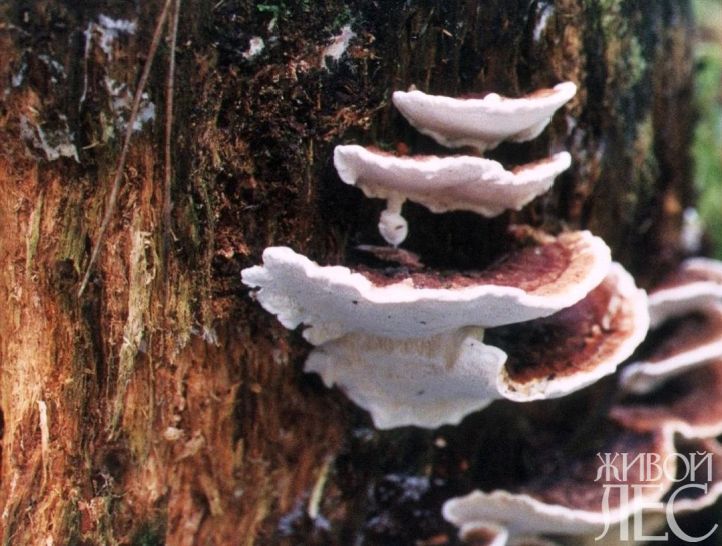
Root sponge on a pine tree stump
Many xylotrophs occupy an intermediate position between saprotrophs and parasites, since they have the ability to switch from a saprotrophic lifestyle to a parasitic one and vice versa. These fungi are dominated by facultative (optional) parasites. They, as a rule, develop on dead wood, dead wood, fallen trees and stumps, however, they can settle on living, but strongly weakened trees, accelerating their desiccation. These include such widespread xylotrophs as Fomitopsis pinicola, Ganoderma lipsiense, Fomes fomentarius, birch sponge (Piptoporus betulinus) and oak sponge (Daedalea quercina), common alkali and etc.
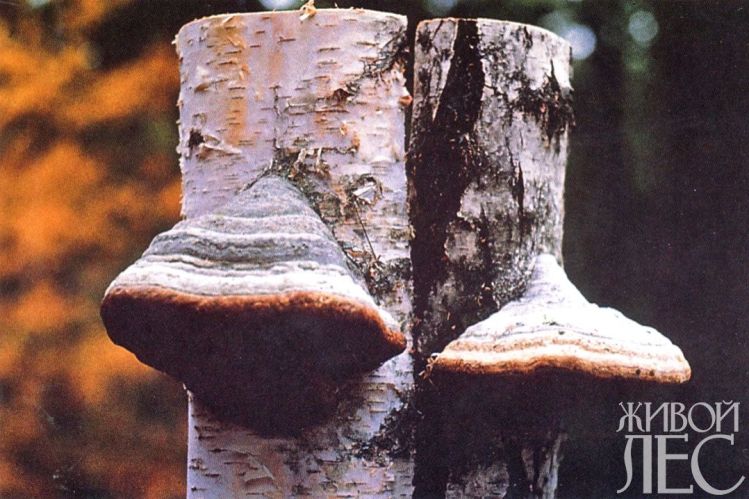
Real tinder
Facultative (optional) saprotrophs are close to parasites in their way of life.These are mushrooms that live mainly on living trees, but they can also exist on dead wood. These include many widespread and dangerous species of xylotrophs, for example, autumn mushroom, sponge sponge (Porodaedalea chrysoloma), scaly tinder fungus (Polyporus squamosus), etc.
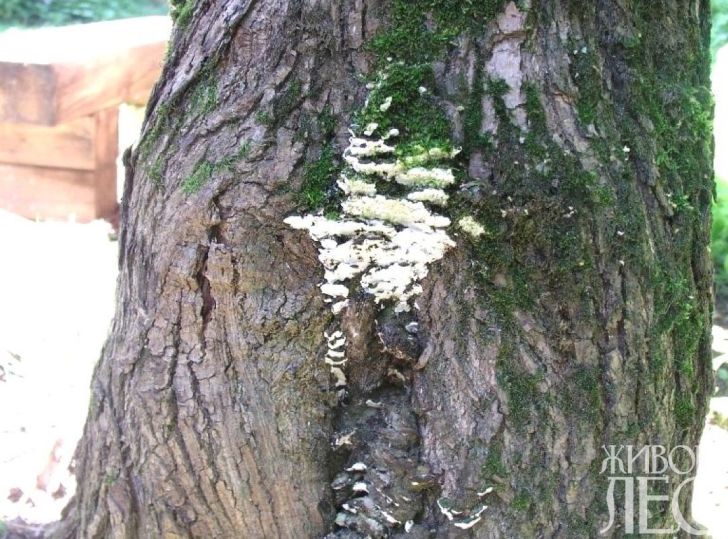
Maple tinder fungus
Xylotrophs that infect living trees are distinguished by their specialization, that is, by their preference for the development of certain species or species of woody plants or organs.
Fungal spores penetrate tree tissues through damage to trunks, branches and roots. In these places of primary infection, the fruiting bodies of pathogens are subsequently formed.



